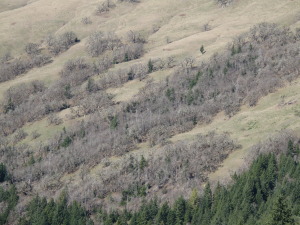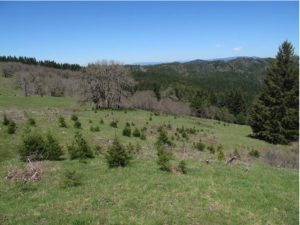Understanding disturbance and vegetation dynamics in northern California oak woodlands
 Example of conifer encroachment in the Bald HillsThe loss of oak woodlands to native conifer encroachment is a major conservation concern in northwestern California and across much of the Pacific Northwest, resulting in associated losses of wildlife habitat, cultural uses, biodiversity, and other ecosystem services. These concerns – compounded by development pressures, evolving understanding of fire’s role in California landscapes, and threats to oak health – have drawn increasing attention in recent years, and oak woodland conservation and restoration efforts have gained momentum. In a new study, funded by ANR, we aim to evaluate oak woodland stand dynamics and conifer encroachment in northwestern California, providing baseline information where existing research has been limited in geography and scope.
Example of conifer encroachment in the Bald HillsThe loss of oak woodlands to native conifer encroachment is a major conservation concern in northwestern California and across much of the Pacific Northwest, resulting in associated losses of wildlife habitat, cultural uses, biodiversity, and other ecosystem services. These concerns – compounded by development pressures, evolving understanding of fire’s role in California landscapes, and threats to oak health – have drawn increasing attention in recent years, and oak woodland conservation and restoration efforts have gained momentum. In a new study, funded by ANR, we aim to evaluate oak woodland stand dynamics and conifer encroachment in northwestern California, providing baseline information where existing research has been limited in geography and scope.
 Douglas-fir invasion into a grassland/oak woodland, Redwood National Park Pairing field-based and remote sensing-based spatial analysis methods, this research would address the following issues:
Douglas-fir invasion into a grassland/oak woodland, Redwood National Park Pairing field-based and remote sensing-based spatial analysis methods, this research would address the following issues:
- What are the rate, extent, and health effects of conifer encroachment in North Coast oak woodlands, and what variables determine rates of encroachment?
- What oak stand structures and age structures are present within encroached areas, and how do they relate to and inform restoration targets?
- How will encroachment rates and patterns shift under changing environmental and climate scenarios?
- How can we inform restoration strategies and better guide the effectiveness of limited conservation dollars?
Collaborators include: Yana Valacovich, Rick Standiford, Matt Potts, Lenya Quinn-Davidson and Melissa Eitzel. Stay tuned for results!